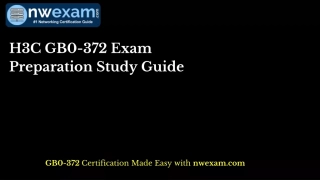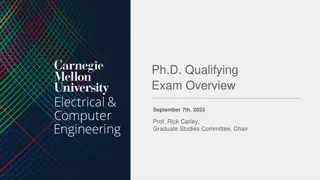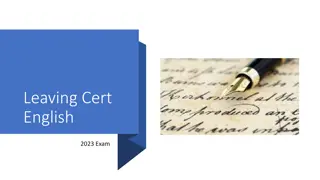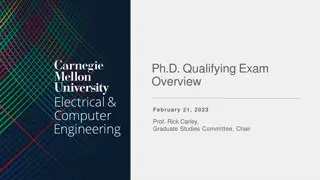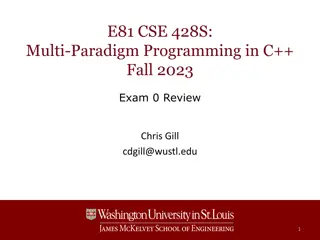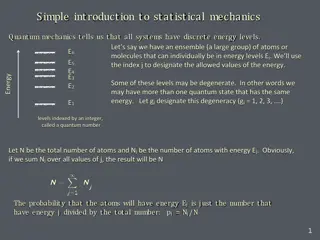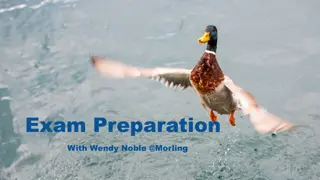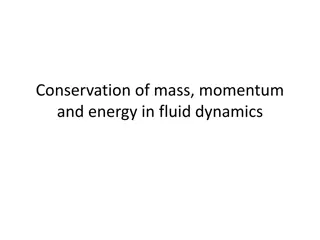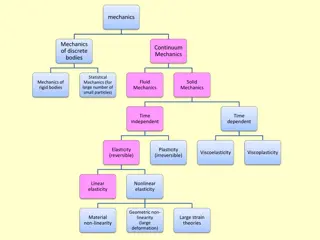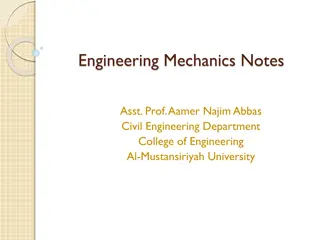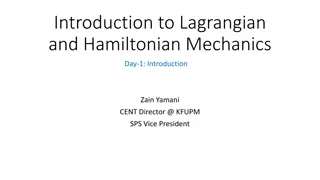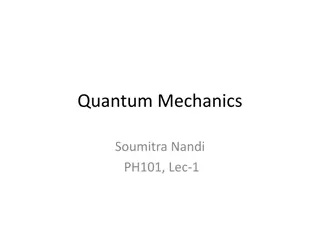Mechanics Exam Preparation Guide
Mechanics exam preparation guide covering topics such as center of gravity, torque calculations, rotational inertia, and Newton’s second law. Includes practice questions and demonstrations to help you understand key concepts. Prepare with your own materials and follow exam guidelines closely to ensure success.
Download Presentation

Please find below an Image/Link to download the presentation.
The content on the website is provided AS IS for your information and personal use only. It may not be sold, licensed, or shared on other websites without obtaining consent from the author. Download presentation by click this link. If you encounter any issues during the download, it is possible that the publisher has removed the file from their server.
E N D
Presentation Transcript
Exam#1 (chapter 1-8) time: Wednesday 03/24 8:30 am- 9:20 am Location: physics building room 112 If you have special needs, e.g. exam time extension, and has not contact me before, please bring me the letter from the Office of the Dean of Students before 03/17. AOB multiple choice problems. Prepare your own scratch paper, pencils, erasers, etc. Use only pencil for the answer sheet Bring your own calculators No cell phones, no text messaging, no computers No crib sheet of any kind is allowed. Equation sheet will be provided. 1
The center of gravity is the point about which the weight of the object itself exerts no torque. We can locate the center of gravity by finding the point where it balances on a fulcrum. What s the center of gravity of a disk? A. any point on the edge of the disk. B. Center of the disk C. Any point half way between the center and the edge. 2
How far can the child walk without tipping the plank? For a uniform plank, its center of gravity is at its geometric center. The pivot point will be the edge of the supporting platform. The plank will not tip as long as the counterclockwise torque from the weight of the plank is larger than the clockwise torque from the weight of the child. The plank will verge on tipping when the magnitude of the torque of the child equals that of the plank. 3
An 80-N plank is placed on a dock as shown. The plank is uniform in density so the center of gravity of the plank is located at the center of the plank. A 150-N boy standing on the plank walks out slowly from the edge of the dock. What is the torque exerted by the weight of the plank about the pivot point at the edge of the dock? a) +80 N m b) -80 N m c) +160 N m d) -160 N m e) +240 N m f) -240 N m 1 m 80 N = +80 N m (counterclockwise) 4
Quiz: An 80-N plank is placed on a dock as shown. The plank is uniform in density so the center of gravity of the plank is located at the center of the plank. A 150-N boy standing on the plank walks out slowly from the edge of the dock. How far from the edge of the dock can the 150-N boy walk until the plank is just on the verge of tipping? a) 0.12 m b) 0.23 m c) 0.53m d) 1.20 m 80 N m / 150 N = 0.53 m 5
Demos: 1Q-09 Demonstration Gyroscopes
Rotational Inertia and Newtons Second Law In linear motion, net force and mass determine the acceleration of an object. For rotational motion, torque determines the rotational acceleration. The rotational counterpart to mass is rotational inertia or moment of inertia. Just as mass represents the resistance to a change in linear motion, rotational inertia is the resistance of an object to change in its rotational motion. Rotational inertia is related to the mass of the object. It also depends on how the mass is distributed about the axis of rotation. 7
Rotational Inertia and Newtons Second Law Newton s second law for linear motion: Fnet = ma Newton s second law for rotational motion: ???? R = m ? Massless bar ? ? ? = ? ? ???? R = m ?2 ?? net = I The rotational acceleration produced is equal to the torque divided by the rotational inertia. ?? 8
Rotational Inertia and Newtons Second Law For an object with its mass concentrated at a point: Rotational inertia = mass x square of distance from axis I = mr2 The total rotational inertia of an object like a merry-go- round can be found by adding the contributions of all the different parts of the object. 9
Two 0.2-kg masses are located at either end of a 1- m long, very light and rigid rod as shown. What is the rotational inertia of this system about an axis through the center of the rod? a) b) c) d) 0.02 kg m2 0.05 kg m2 0.10 kg m2 0.40 kg m2 I = mr2 = (0.2 kg)(0.5m)2 x 2 = 0.10 kg m2 10
Rotational inertias for more complex shapes: 11
Angular Momentum Linear momentum is mass (inertia) times linear velocity: p = mv Angular momentum is rotational inertia times rotational velocity: L = I Angular momentum may also be called rotational momentum. A bowling ball spinning slowly might have the same angular momentum as a baseball spinning much more rapidly, because of the larger rotational inertia I of the bowling ball. 12
Angular momentum is a vector The direction of the rotational-velocity vector is given by the right-hand rule. The direction of the angular-momentum vector is the same as the rotational velocity. Inertia I, rotational velocity Angular momentum : L= I 13
Conservation of Angular Momentum net = I = = ? ? ?= ?? = ? ? ? i.e. the direction of the angular momentum change is the same as that of the net toque. When net = 0, ? ? = 0, i.e. L = const. 14
Conservation of Angular Momentum = v p m F a Inertia : m m net = F p 0, = constant = If net = Inertia : I I net = = L L I constant = If 0, net 15
Demos: 1Q-09 Demonstration Gyroscopes
Quiz: Some new 2-wheel motocycles can stand by itself without support when not moving. A. Not possible. B. Possible. Angular Momentum conservation is in action. https://www.youtube.com/watch?v=1KmhTfhaWG8 17
Kinetic Energy ?? =? =1 2??2?2 ???? =? ???? 18
1Q- 23 Conservation of angular momentum Changing the moment of inertia of a skater How does conservation of angular momentum manifest itself ? When pulling in both arms, the person will spin: A. Faster B. Slower C. Same speed 9/26/2024 Physics 214 Fall 2009 19 19
1Q-32 Stability Under Rotation Example of Gyroscopic Stability: Swinging a spinning Record Why does the Record not flop around once it is set spinning ? L L 9/26/2024 Physics 214 Fall 2009 20 20
1Q-30 Bicycle Wheel Gyroscope Gyroscopic action and precession L What happens to the wheel, does it fall down? F mg F = mg 21 21
1Q-21 Conservation of angular momentum Conservation of angular momentum using a spinning wheel When the wheel is inverted, the stool A. Rotate B. Stay as is. 9/26/2024 22 22
A student sits on a stool holding a bicycle wheel with a rotational velocity of 5 rad./s about a vertical axis. The rotational inertia of the wheel is 2 kg m2 about its center and the rotational inertia of the student and wheel and platform about the rotational axis of the platform is 6 kg m2. What is the initial angular momentum of the system? a) b) c) d) 10 kg m2/s upward 25 kg m2/s downward 25 kg m2/s upward 50 kg m2/s downward L = I = (2 kg m2)(5 rad./s) = 10 kg m2/s upward from plane of wheel 23
Quiz: A student sits on a stool holding a bicycle wheel with a rotational velocity of 5 rad./s about a vertical axis. The rotational inertia of the wheel is 2 kg m2 about its center and the rotational inertia of the student and wheel and platform about the rotational axis of the platform is 6 kg m2. If the student flips the axis of the wheel, reversing the direction of its angular-momentum vector, what is the rotational velocity of the student and stool about their axis after the wheel is flipped? a) b) c) d) 1.67 rad/s 3.33 rad/s 60 rad/s 120 rad/s = L / I = (20 kg m2/s) / (6 kg m2) = 3.33 rad/s in direction of original angular velocity 24


